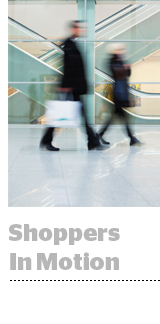
Unlikely insights into consumer behavior can help move the needle, and location data is a rich source of unlikely insights.
On Tuesday, UK-based location data company Blis released an analytics tool in beta called Smart Trends that blends point-of-interest (POI) data and offline movement data to draw conclusions about how people interact with physical locations – and the results don’t always align with conventional wisdom.
For example, as counterintuitive as it sounds, opening a new store close to a competitor could be good for business, said Alex Wright, head of insights at Blis, which used Smart Trends to compare the online and offline shopping behavior of consumers across a handful of well-known brands in large cities across the world, including Berlin, Dubai, London, New York, Singapore and Sydney.
A brand like H&M, which Blis found enjoys high foot-traffic volumes in almost every city the company tested, benefits from placing stores near larger “destination” retailers because of “the inevitable crossover foot traffic that occurs between retailers in the same sector,” Wright said.
Blis derives these insights by collecting time-stamped location data attached to anonymized device IDs from verified GPS and Wi-Fi data and beacon signals, which it then connects to specific points of interest.
Over time, Wright said, these location data “snapshots” develop “an objective picture of spatial behavior,” and can be used for building out consumer profiles, targeting and attribution. In other words, where people go says a lot about them.
WPP-owned media agency Mediacom, an early test partner for Smart Trends, is increasingly turning to location data to help clients “gain a fuller, richer view” of consumer behavior and help planners understand how people interact with competitive brands, said Ben Phillips, the agency’s global head of mobile.
“Such insights are hugely valuable across [a brand’s] businesses, because they can help them make strategic decisions about the products they carry, store locations and targeting techniques,” he said.
Mediacom recently worked with Blis to run a pilot test studying foot traffic across the national grocery market in the UK, an extremely competitive sector, said Phillips, where shopping is still mainly an offline experience.
“Promotions and store openings [are] constantly shifting the dynamics on local battlegrounds as retailers fight to increase shopper frequency or grow average basket value, which ultimately impacts revenue market share at a brand level,” he said.
Looking at movement data gave Phillips and his crew deeper insight into the real-world store-to-store behavior of shoppers, the granularity and scale of which “survey data simply can’t match.”
Even the most sophisticated brands often have a myopic view of consumer behavior because they’re only looking at it from the inside out. Even the most loyal customers in the world don’t spend all of their time engaging with one brand. Location-based analytics helps expand the view beyond a brand’s own properties.
“To get a more holistic perspective, a view on how consumers behave with your brand in the context of your competitors and beyond in non-retail environments can be valuable in identifying lifestyle indicators to inform brand positioning or cross-vertical partnerships,” Wright said.
Mediacom sees the value. The agency is planning to up its investment in location data and analytics in the coming year.
“Nearly 100% of our digital campaigns include mobile in one form or another,” Phillips said. “And location will account for a large percentage going into 2018.”
This post was syndicated from Ad Exchanger.

More Stories
Tokyo hosts first-ever OOH industry conference
Digital Evolution and Omnichannel Success With Monster Energy
Call for entries campaign for Gerety 2025